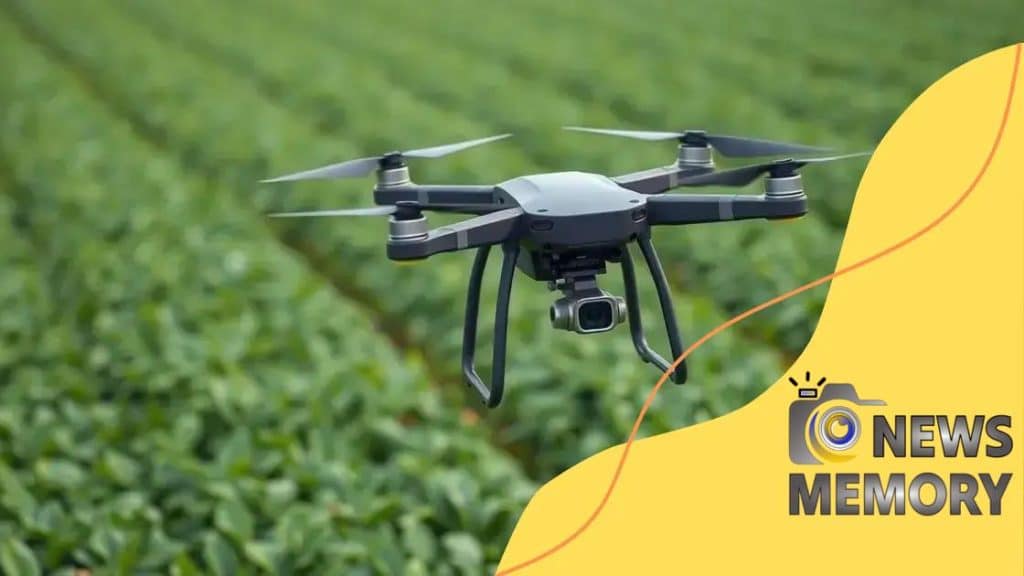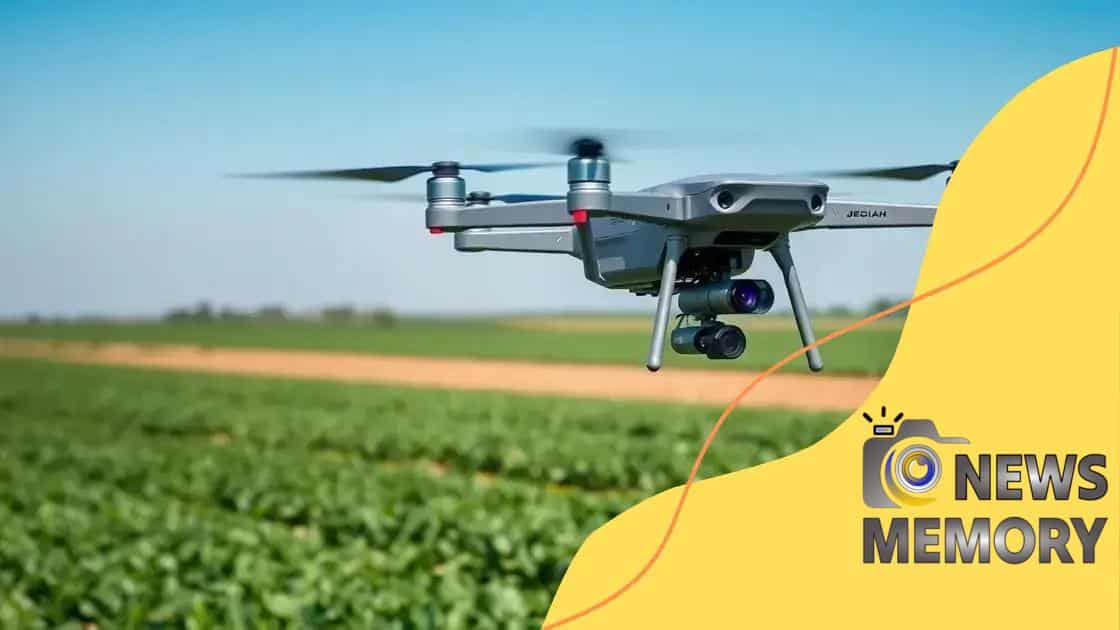The role of drone technology in modern agriculture

The role of drone technology in modern agriculture enhances crop monitoring, optimizes resource use, and promotes sustainable practices, making farming more efficient and accessible.
The role of drone technology in modern agriculture is reshaping the way farmers manage their fields and resources. Have you ever wondered how these flying devices are making a difference in crop yields and farm efficiency?
Understanding drone technology in agriculture
The use of drone technology in agriculture is an exciting trend that is reshaping farming practices today. Farmers are increasingly turning to these advanced tools to boost productivity and efficiency across their vast fields.
What are Agricultural Drones?
Agricultural drones are unmanned aerial vehicles (UAVs) specifically designed to assist in farming. Equipped with high-resolution cameras and sensors, they provide real-time data that is invaluable for farmers. With this information, farmers can diagnose issues, optimize their resources, and enhance their crop yields.
Key Features of Drones in Agriculture
- Real-time monitoring: Drones can capture images and data quickly, allowing farmers to assess the health of their crops continuously.
- Precision agriculture: They help in applying fertilizers and pesticides with accuracy, reducing waste and environmental impact.
- Map creation: Drones can create 3D maps and models of fields, which are useful for planning and management.
The technology behind drones includes GPS, advanced sensors, and imaging technology, providing farmers with critical insights. The integration of drone technology enables farmers to make informed decisions based on accurate data.
Benefits of Using Drones
Employing drones can lead to significant benefits for agricultural operations. They enhance efficiency by allowing quick aerial inspections, reducing the time spent on traditional monitoring methods. Furthermore, the data collected can reveal patterns that might go unnoticed from ground level, such as variations in plant health or moisture levels.
The affordability of drones is also a key factor in their adoption. As technology advances, the cost of acquiring and operating these devices is decreasing, making them accessible to more farmers.
In addition to improving productivity, drone technology plays a role in sustainability. By enabling precise application of resources, they help reduce overuse of water and chemicals, promoting environmentally friendly farming practices.
Benefits of using drones for crop monitoring
The benefits of using drones for crop monitoring are transforming the future of agriculture. Farmers can now leverage drone technology to monitor their fields like never before.
Improved Crop Health Assessment
Drones offer a bird’s-eye view of crops, allowing farmers to quickly identify health issues. With detailed images, they can spot problems that are not visible from the ground, enabling early intervention. This proactive approach helps in maintaining healthy plants and maximizing yields.
Efficient Resource Management
- Targeted Irrigation: Drones can assess moisture levels across a field, guiding precise irrigation decisions.
- Accurate Fertilization: By identifying nutrient deficiencies, drones help in applying fertilizers more effectively.
- Pest Detection: Early detection of pests can save crops from extensive damage.
With these insights, farmers can make data-driven decisions. This not only ensures better crop health but also promotes efficient use of resources. The ability to monitor large areas in a short time frame is a game changer.
Cost-Effectiveness
Another major advantage is the cost savings associated with using drones. Traditional monitoring methods can be labor-intensive and time-consuming. Drones reduce the need for extensive manual labor, saving both time and money.
In addition, the data gathered allows for better planning and management, reducing the overall operational costs for farmers. This technology is paving the way for more sustainable farming practices.
As drone technology continues to evolve, its role in crop monitoring will likely expand, offering even more benefits to farmers worldwide.
How drones are revolutionizing precision agriculture

Drones are truly revolutionizing precision agriculture. With their advanced capabilities, they allow farmers to monitor crops and fields more accurately than ever before.
Enhanced Data Collection
Using drones equipped with sensors and cameras, farmers can quickly collect valuable data on crop health, soil conditions, and more. This information helps in making informed decisions. High-resolution images provide insights into plant health that are hard to see from the ground.
Real-Time Analysis
- Disease Detection: Drones can identify early signs of diseases in crops, allowing for swift intervention.
- Water Management: By assessing moisture levels, drones help farmers apply water more efficiently, reducing waste.
- Yield Prediction: Accurate data helps in predicting yields, enabling better planning for harvest.
This approach empowers farmers to address issues before they become bigger problems, ultimately increasing efficiency and yields. Monitoring large areas becomes less labor-intensive and more precise.
Cost and Time Efficiency
Using drones in farming leads to significant cost savings. Traditional methods involve extensive labor and time. Drones automate many processes, allowing farmers to focus on other critical tasks. Moreover, the cost-effectiveness of drone technology means that more farmers can access these tools, leveling the playing field.
The integration of drone technology in precision agriculture is paving the way for smarter farming methods. It represents a shift towards data-driven decision-making, ensuring that resources are used wisely and sustainably. Farmers can optimize their operations while promoting environmentally friendly practices.
Safety and regulations for agricultural drones
Safety and regulations for agricultural drones are crucial as their use continues to grow in farming. Compliance with these guidelines helps ensure safe and effective operations in the field.
Understanding Regulations
The regulations surrounding agricultural drones vary by region but generally focus on ensuring safety for both operators and the public. It is essential for farmers to familiarize themselves with local laws addressing drone use. Most countries require drone operators to register their drones and may also enforce restrictions on where and when they can fly.
Compliance with Safety Guidelines
- Training and Certification: Operators should seek training to understand how to fly drones safely and comply with regulations.
- Maintenance: Regular maintenance checks are essential to ensure that drones are functioning correctly and safely.
- Insurance: Having insurance can protect farmers from liability in case of accidents or incidents during drone operations.
Farmers can reduce risks by adhering to these safety precautions. Drone collisions or mishaps can cause significant damage to crops, equipment, and even people.
Best Practices for Safe Operations
Implementing best practices is key for successful drone operations in agriculture. Operators should always conduct pre-flight checks to ensure the equipment is in good working condition. It is also advisable to maintain a safe distance from people and animals when operating drones, minimizing potential risks.
Using drones in agricultural settings offers great advantages, but safety should remain a priority. Staying informed about the latest regulations and following recommended practices helps foster a culture of safety, ensuring that the benefits of drone technology are realized without compromising security.
Future trends of drone technology in farming
The future trends of drone technology in farming promise exciting advancements that will further enhance agricultural practices. As technology evolves, so does the potential for drones to transform agriculture.
Increased Automation
One significant trend is the move towards greater automation. Drones will increasingly integrate with other technologies, such as machine learning and artificial intelligence. This integration allows drones to make real-time decisions based on the data they collect.
Collaboration with Other Technologies
- IoT Integration: Drones will work alongside Internet of Things (IoT) sensors placed within fields to gather comprehensive data.
- Data Analytics: Enhanced data analytics will improve decision-making by providing deeper insights into farming practices.
- Robotic Systems: Collaboration with robotic systems will allow for automated planting and harvesting.
This collaboration will lead to more precise farming practices, optimizing resource use and maximizing crop yields. With AI and machine learning, drones can continuously improve their operations by learning from past data.
Cost Reduction and Accessibility
As technology progresses, drones are expected to become more cost-effective. This reduction in price will make drones accessible to more farmers, including smallholders who could greatly benefit from precision agriculture.
With lower entry costs, more farmers will be able to utilize drone technology, leading to widespread improvements in productivity and efficiency. Additionally, advancements in battery life and flight time will enhance the usability of drones across larger fields.
Regulatory Advances
Future trends also include the evolution of regulations surrounding drone use. As the technology becomes more common, governments will likely adapt their regulations to balance safety with agricultural innovation.
These changes will facilitate the integration of drones into daily farming operations while ensuring safety and compliance.
In summary, the role of drone technology in modern agriculture is profound and far-reaching. Drones enhance efficiency, promote sustainability, and make farming more accessible and profitable for farmers of all sizes. As agricultural technology continues to advance, we can expect further innovations that will continue to transform the farming landscape, making it more productive and environmentally friendly. Embracing these trends will be key for farmers looking to thrive in a competitive market.
FAQ – Frequently Asked Questions About Drone Technology in Agriculture
How do drones improve crop monitoring?
Drones provide high-resolution images and real-time data, allowing farmers to assess crop health and diagnose issues quickly.
What are the key benefits of using drones in farming?
Drones enhance efficiency, reduce resource waste, and enable precise application of fertilizers and pesticides.
What regulations should farmers consider when using drones?
Farmers must familiarize themselves with local laws regarding drone registration, flight restrictions, and safety guidelines to ensure compliance.
What future trends can we expect in drone technology for agriculture?
Future trends include increased automation, improved integration with AI, and greater accessibility for farmers due to reduced costs.





